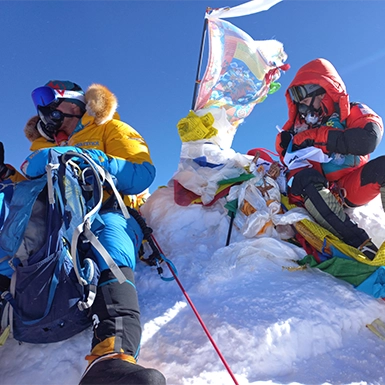Kathmandu, Nepal – Nepal is implementing a sweeping overhaul of its climbing permit fee structure, impacting world-renowned peaks like Mount Everest and dozens of other popular Himalayan destinations. The Nepal Climbing Permit Fee Increase, announced jointly by the Nepalese government and the Nepal Mountaineering Association (NMA), aims to balance promoting tourism, ensuring environmental sustainability, and supporting the local communities that depend on the mountaineering industry. This marks a significant shift in how Nepal manages its precious mountain resources.

Phase One: Everest and 8,000-Meter Giants See Immediate Royalty Hike (September 2024)
The first phase of the Nepal Climbing Permit Fee Increase takes effect on September 1, 2024 (16 Bhadra 2081 in the Nepali calendar). This phase focuses on Mount Everest and other peaks exceeding 8,000 meters in elevation:
- Mount Everest: The iconic peak sees a substantial increase in royalty fees:
- Spring Season (March-May): USD 15,000 per person (up from USD 11,000). This is the most popular climbing season.
- Autumn Season (September-November): USD 7,500 per person (up from USD 5,500).
- Winter/Summer Seasons: USD 3,750 per person (up from USD 2,750).
- Other 8,000-Meter Peaks: These giants, including Kanchenjunga, Lhotse, Makalu, and Cho Oyu, also see significant fee increases:
- Spring Season: USD 10,000 per person.
- Autumn Season: USD 5,000 per person.
- Winter/Summer Seasons: USD 2,500 per person.
The government cited overcrowding, environmental concerns, and the need for enhanced safety measures as key drivers behind the Everest fee hike.

Phase Two: NMA-Managed Peaks Undergo Comprehensive Fee Restructuring (January 2025)
The second phase, effective January 2025, targets over 30 Himalayan peaks managed by the Nepal Mountaineering Association (NMA). This phase introduces a more nuanced, tiered pricing system:
- Popular Trekking Peaks: Popular peaks like Island Peak (Imja Tse) and Mera Peak, often chosen by climbers gaining experience before tackling higher summits, will see notable increases:
- Island Peak (6,189m): Spring season permit will be $500 per climber (increased from $350).
- Mera Peak (6,476m): Autumn season permit will be $400 per climber (increased from $250).
- Newly Opened and Less-Frequented Peaks: The NMA offers discounted rates on newly opened peaks and those receiving fewer expeditions to encourage exploration and distribute climbing pressure. For example, a permit for Cholatse will be $600.
- Group Discounts: To encourage larger climbing groups and their economic contributions, parties of five or more mountaineers will benefit from a 15% reduction in their overall permit costs. This encourages group bookings.
- Conservation Levy: A mandatory $50 surcharge will be added to every climbing permit. This dedicated fund will be used directly for trail maintenance, waste management initiatives, and other environmental protection efforts.
Beyond Fees: New Climbing Regulations and Requirements
The Nepal Climbing Permit Fee Increase is accompanied by new regulations designed to enhance safety and sustainability:
- Mandatory GPS Tracking: All climbers must carry GPS tracking devices regardless of the peak they are attempting. This will improve safety and allow better emergency monitoring of climbers’ locations.
- Proof of Eco-Friendly Gear: Expedition teams must demonstrate that they are using environmentally responsible equipment. This includes, but is not limited to, portable toilets. This requirement aims to minimize the impact of human waste on the mountain environment.
- Stricter Enforcement: The government and the NMA have pledged to enforce these regulations rigorously. This includes monitoring flight paths, checking permits, and ensuring compliance with waste disposal guidelines.
The Rationale: Why the Nepal Climbing Permit Fee Increase?
The driving force behind these comprehensive changes is a commitment to sustainable tourism. Nepal recognizes that its mountains are a precious resource. These must be managed responsibly. The key objectives include:
- Environmental Protection: Reducing the impact of overcrowding, waste, and noise pollution on fragile ecosystems.
- Revenue Generation: Increasing revenue to fund conservation projects, improve infrastructure, and support local communities.
- Enhanced Safety: Improving safety measures for climbers, including rescue services and better communication.
- Promoting Quality Tourism: Attracting experienced and responsible climbers willing to invest in a sustainable Everest experience.
- Supporting Local Communities: Directing a portion of the increased revenue towards development projects in mountain villages.

Industry Reactions: A Mixed Bag
The response to the Nepal Climbing Permit Fee Increase has been varied:
- International Climbing Community: Some climbers have expressed concern about the higher costs, particularly for independent climbers and smaller expeditions. Others acknowledge the need for increased funding for conservation and safety.
- Nepalese Trekking Agencies: Local trekking agencies generally support sustainability goals. However, some express concern that the higher fees deter budget travelers, potentially impacting the volume of business.
- Local Communities: Residents of mountain regions broadly welcome the changes. They anticipate benefits from improved infrastructure and increased economic opportunities.
- NMA Stance NMA President Santosh Gurung stated, “The adjustments reflect the need to manage Nepal’s peaks sustainably. Revenue will directly support remote mountain villages and environmental initiatives.”
The Future of Climbing in Nepal: A Balancing Act
The Nepal Climbing Permit Fee Increase represents a significant turning point in Nepal’s approach to mountaineering tourism. This action demonstrates an increasing worldwide understanding of the importance of sustainability in adventure tourism. For these changes to be successful, key elements include effective implementation, transparent handling of finances, and continuous communication among all involved parties. The international community will closely watch Nepal’s commitment to balancing economic growth with environmental protection. The goal is clear: to ensure that the majestic Himalayas remain a source of wonder and adventure for generations while benefiting the communities that call these mountains home. This is not just about climbing; it’s about preserving a unique natural and cultural heritage.
Reference: Increased Royalty on Mountain Climbing Implemented from 1st September 2025


